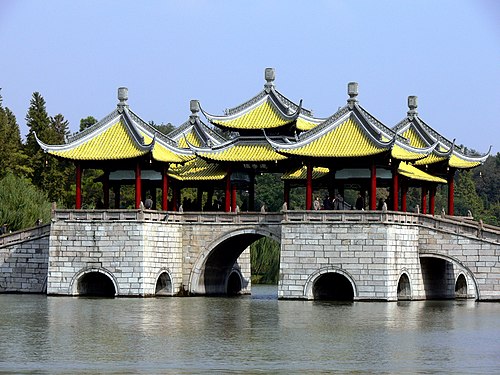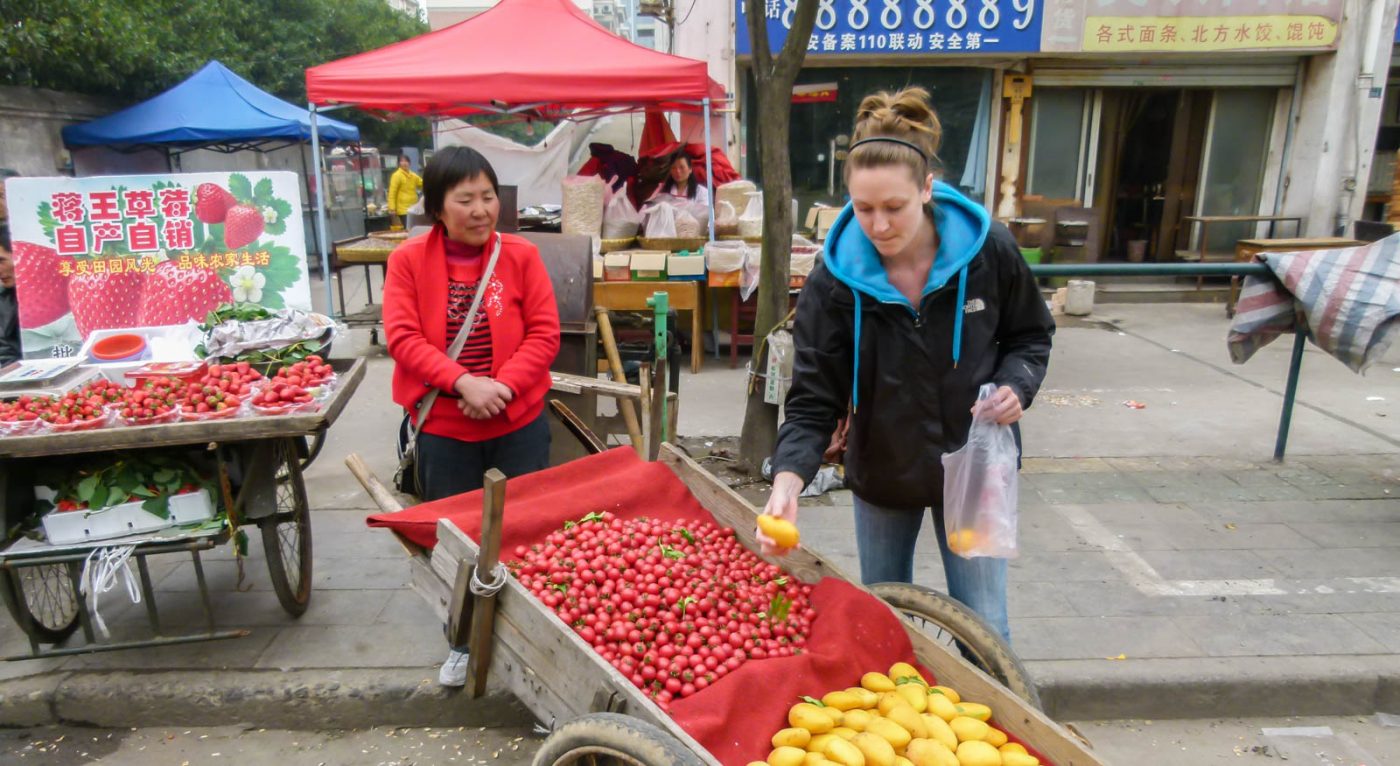Yangzhou
About Yangzhou

Yangzhou is a prefecture-level city in central Jiangsu Province, China. Historically, Yangzhou was one of the wealthiest cities in China, known at various periods for its great merchant families, poets, artists, and scholars. Its name refers to its former position as the capital of the ancient Yangzhou prefecture in imperial China. Yangzhou was one of the first cities to benefit from one of the earliest world bank loans in China, used to construct Yangzhou thermal power station in 1994. Sitting on the north bank of the Yangtze, it borders the provincial capital Nanjing to the southwest, Huai'an to the north, Yancheng to the northeast, Taizhou to the east, and Zhenjiang across the river to the south. Its population was 4,414,681 at the 2010 census and its urban area is home to 2,146,980 inhabitants, including three urban districts, currently in the agglomeration.
Cuisine

Yangzhou dishes may be one of the reasons why the people of Yangzhou are so infatuated with their city. They have an appealing color, aroma, taste and appearance. The original color of each ingredient is preserved after cooking, and no oily sauce is added, so as to retain the fresh flavour of the food. In Yangzhou all dishes, whether cheap or expensive, are elaborate. Cooks will not scrimp on their work, even with dazhu gansi (Chinese: 大煮干丝; pinyin: dàzhǔ gānsī), a popular dish that costs only a few yuan. Dry bean curd is made by each restaurant that serves it, so the flavor is guaranteed. The cook slices the 1-cm-thick curd into 30 shreds, each one paper-thin but none broken, and then stews them for hours with chopped bamboo shoots and shelled shrimps in chicken soup. In this way the dry bean curd shreds can soak up the flavor of the other ingredients, and the soup is clear but savory. Not only Yangzhou cooks, but also the ordinary people are conscientious about cooking.
Economy
In the process of economic development, Yangzhou attaches great importance to building high-quality platforms and carriers for enterprises. The city has built 11 development parks above the provincial level. There are more than 12,000 existing enterprises in the park, including nearly 1,300 industrial enterprises above designated size. In 2018, 11 development parks above the provincial level completed a GDP of 293.84 billion yuan, accounting for 53.8% of the city. Among them, Yangzhou Economic and Technological Development Zone focuses on the development of green optoelectronics, automobiles and parts and other industries. Yangzhou High-tech Industrial Development Zone focuses on the development of CNC equipment manufacturing, biotechnology and other industries.
Under the guidance of technological innovation, in 2018, the city achieved a GDP of 546.617 billion yuan, a comparable growth of 6.7%, and a per capita GDP of 18,277 US dollars. The general public budget revenue is 34.003 billion yuan. The per capita disposable income of urban permanent residents and the per capita disposable income of rural permanent residents reached 4,1999 yuan and 21,457 yuan respectively, with increases of 8.2% and 8.9% respectively. Total retail sales of social consumer goods was 155.703 billion yuan, with an increase of 9.2%
Geography

Neighborhoods
Yangzhou's main urban area (the "city proper") is criss-crossed by an intricate network of canals and small lakes. The historic city center (the former waled city) is surrounded by canals on all sides: the Old Grand Canal forms its eastern and southern boundaries; the City Moat Canal runs along the former walled city's northern edge, connecting the Old Grand Canal with the Slender West Lake; the Erdaohe Canal runs along the old city's western edge, from the Slender West Lake to the Lotus Flower Pond (Hehuachi), which in its turn is connected by the short Erdaogou canal with the Old Grand Canal.[21] It is possible to sail a small water craft from the Thin West Lake, via the Erdaohe, the Hehua Pond, and the Erdaogou into the Old Grand Canal.
Transportation
Yangzhou has one Yangtze River crossing, the Runyang Yangtze River Bridge complex, which has one of the longest suspension bridge spans in the world, and carries the G4011 Yangzhou–Liyang Expressway to Zhenjiang.
The city is served by an extensive network of public bus routes.vYangzhou's taxi industry began in 1982, and has developed rapidly since 1993. the city has over 40 taxi companies of various ownership structures, with a total of 1,571 vehicles. Parking lots were established at key stations and hotels, and eight taxi companies have opened round-the-clock telephone service. The construction department of the municipal government has strengthened the management of taxi services, providing education in the relevant laws, professional ethics and safety aspects.
In 2014, Yangzhou's government approved plans for the construction of a subway system, which will initially include two lines. Line 1 will run in the general east-west direction, from Yangzhou Railway Station in the west to the historic central city to the future high-speed railway station (east of the Grand Canal) to Jiangdu District. Line 2 will run in the general north-south direction.
History

Notable Events
Guangling , the first settlement in the Yangzhou area, was founded in the Spring and Autumn period. After the defeat of Yue by King Fuchai of Wu, a garrison city was built 12 m above the water level on the north bank of the Yangtze c. 485 BC. This city in the shape of a three by three li square was named Hancheng.
The newly built Han canal formed a moat around the south and east sides of the city. The purpose of Hancheng was to protect Suzhou from naval invasion from Qi. During the Han dynasty, Guangling was the seat of Guangling Commandery. It constituted a part of the Xu Province, rather than the Yang Province, which was covered the entire southeastern part of China then. In 590, the city was made the capital of a newly established Yang Prefecture, and began to be referred to with its current name.
Yangzhou is famous for its carved lacquerware and jade. Its famous "FeiCuiBaiCai" is a world famous carved jade and was displayed in the Chinese National Pavilions during the EXPO 2010 Shanghai Jade carving is one of the oldest carving varieties in China. Jade is processed and carved into exquisite crafts, called jade carvings.
Major Attractions
Slender West Lake

Named after Hangzhou's famous West Lake, this long, narrow stretch of water which meanders through Yangzhou's western limits is a well-known scenic spot. A long bank planted with weeping willows spans the lake; at its midpoint stands a square terrace with pavilions at each of the corners and one in the center. Around the lake is a park in which are found several attractions: Lotus Flower Pagoda (Lianhua SO), a white structure reminiscent of the White Pagoda (Baita) in Beijing's Beihai Park; Small Gold Mountain (Xiao Jin Shan); and the Fishing Platform (Diaoyutai), a favorite retreat of the Qing emperor Qian Long. The emperor was so gratified by his luck in fishing at this spot that he ordered additional stipends for the town. As it turns out, his success had been augmented by local swimmers who lurked in the lake busily attaching fish to his hook.
Daming Temple
Located on Shugang Hill, in the city's northwest, is Fajing Temple, formerly known as DaMing Temple. The original temple was built in Liu Song Dynasty (420–479). A nine-story pagoda, the Qilingta, was built on the temple grounds in the year of Sui Dynasty (589–618) . A recent addition to the temple complex is the Jianzhen Memorial Hall, built according to Tang Dynasty methods and financed with contributions raised by Buddhist groups in Japan. When Qing Emperor Qian Long visited Yangzhou in 1765, he was troubled by The temple's name DaMing (which literally means "Great Ming') fearing that it might revive nostalgia for the Ming Dynasty, which was overthrown by his Manchu predecessors. He had it renamed Fajing Temple. The temple was seriously damaged during the Taiping Rebellion at the beginning of the 20th century. The present structure is a reconstruction dating from the 1930s.
Tomb of Puhaddin
This is essentially a Ming Dynasty graveyard that includes the tomb of Puhaddin. According to information at the tomb, he was a 16th generation descendant of Muhammad, The Prophet. The tomb is on the eastern bank of the (Old) Grand Canal in the eastern sector of the city and is adjacent to a mosque which houses a collection of valuable materials documenting China's relations with Muslim countries